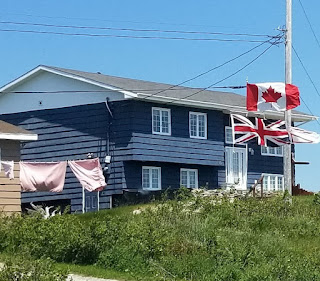#24 Codroy,
Newfoundland Part 1
WOW! What a first day!
Monday July 8, 2019
The guys walked and
were ready to go about 11 AM. We
expected a short outing to see the local area.
Well, 9 hours later we returned home!
Commercial buildings
resemble simple box architecture. A
simple name on the building indicates what you will find inside. The lack of display windows probably
correlates with the severity of the winters.
We watched this large
ship arrive in port.
When we read about
old fishing villages our expectations went to those on the Washington and
Oregon coast. Coastal homes show the
weather beaten effects of nature on their siding. The gray shakes fade with time. The roofs are
similar.
During our travels
you can’t help but notice the wide array of vibrant colors on the houses. Each house and yard looks exceptionally well
maintained. What we have learned during
our stay in Codroy, is that about 20 years ago aluminum siding came to the
valley. This siding comes in a variety
of colors and is virtually carefree.
Wooden structures need to be repainted annually. We also noticed a lot of huge, new garages
being built as we drove around.
Clothes hanging out
on the line to dry happened in all the communities. Many ran a single line on a pulley from the
deck to a pole. Notice the blue houses
behind the laundry.
Churches stand tall
and grand all over the island. This one
stands on a hill in Port aux Basques.
This rock in
someone’s front yard shows how rock is a natural part of the environment here.
Newfoundland is
referred to as “the rock”. And rock it
is! Exposed rock juts out between
forests of small trees. The dark
little conifers, maybe black or white spruce, provide contrast to the bright
green deciduous trees. Also the abrupt
timber line looks like the lack of dirt rather than elevation may stop growth
near the top.
This is called Table
Mountain.
Indigo
lakes settle into every nook and cranny. Their vivid color reflected from the
blue sky. Their sizes vary from a lake
to large puddle. Some wash iron-colored water near the shore. On a cloudy day, the indigo becomes almost
black. Some have salty looking waves and froth.
The ones we assume are fresh water also
provide a place for lily pads to develop with bright yellow flowers.
Rivers flow with the
same dark indigo color. We stopped and
walked back to a bridge for these photos.
The few locals that passed by probably got a good laugh.
The ocean
shoreline generally looks like
this. However some have sandy beaches
and other areas have rocky beaches.
Lake shorelines can
look like this.
The first part of the
day we ventured east of Port aux Basques along the southern shore called the
Granite Coast Drive. We visited the
villages of Isle aux Morts, Margaree, Burnt Islands, and Rose Blanche.
At Diamond Cove we saw the white granite
cliffs. Earlier people thought they
might have diamonds…but no.
Rose Blanche sits
among the rocks next to the sea. I took
a photo of a winter picture of Rose Blanche.
I saw this at the gift shop at Rose Blanche and in other places. They are called a Killick which is a homemade wooden anchor.
The path to the
lighthouse showed us beautiful views on the sunny, but windy day. Reader boards
offered interesting historical
information.
The Rose Blanche
Lighthouse built in 1871 made the trip out here worthwhile. The lighthouse construction used granite
from a local quarry. It remains one of
the few granite lighthouses on the Atlantic Coast. The lighthouse was operational from 1871 to the 1940’s, then it fell in disrepair. Then in 1988 they
begin to restore it, and finished in 1999.
The main floor supports a great room and an
office.
Upstairs has 3
bedrooms. One held artifacts from the time.
The stairs up to the light
were blocked for safety.
We couldn’t imagine
living out here any time of year and especially not in winter. We arrived on a sunny day in July and the wind blew cold and fierce! This part of Newfoundland didn’t have
electricity until 1965! Brrrrrrrrrr
The rest of today can
be found in Codroy Part 2






























































No comments:
Post a Comment